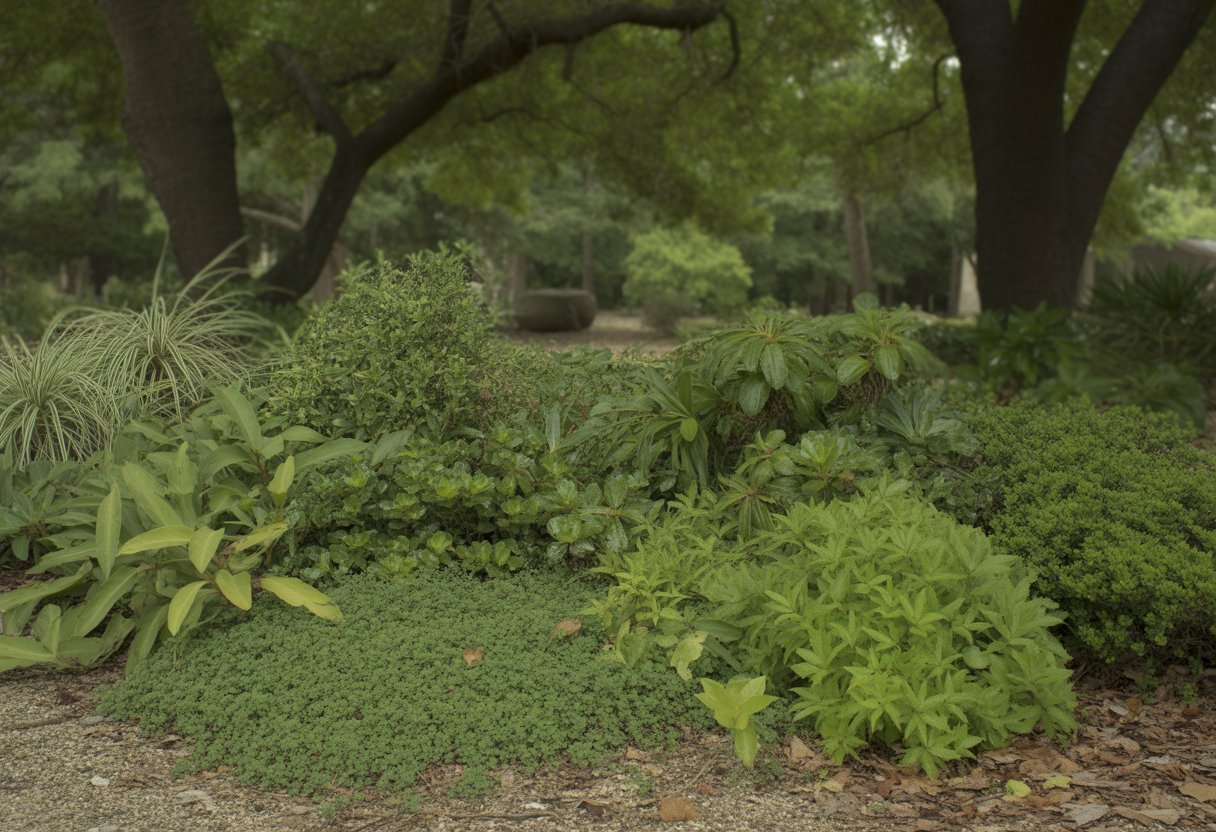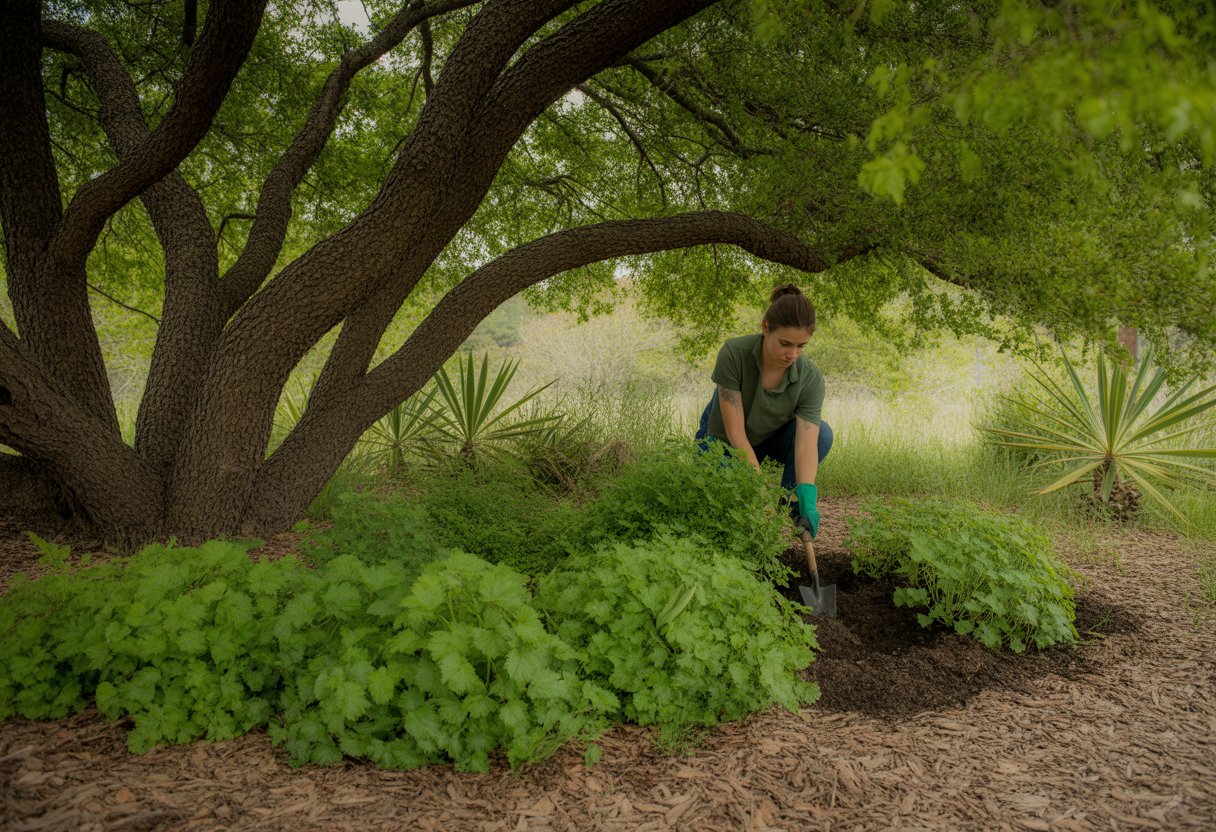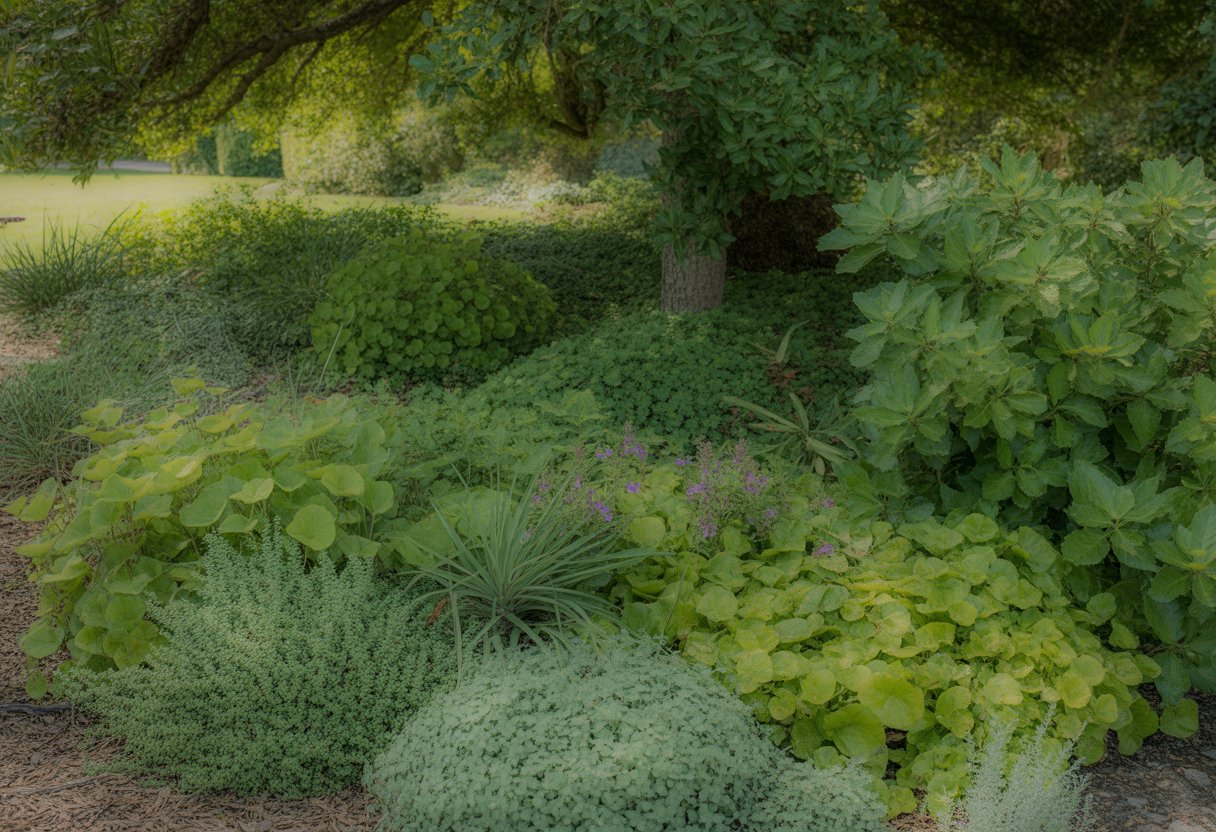Shade Loving Ground Covers Texas Best Plants for Low-Light Gardens
Texas gardens often have shaded corners where grass just won’t thrive. Ground covers really come in handy here.
Shade-loving ground covers like ajuga, mondo grass, and liriope do well in low-light spots, giving you dependable greenery even when the sun barely peeks in. They help keep weeds down, fight erosion, and add a bit of texture to shadowy landscapes.

Picking the right ground cover depends on your soil, moisture, and just how much shade you’re dealing with. Luckily, there are options that handle Texas heat and humidity while still filling in those tricky spots under trees.
Best Shade Loving Ground Covers for Texas
Shade-tolerant ground covers in Texas need to handle tough soil, high temps, and sometimes drought. A handful of choices really shine, each bringing its own style and care needs.
Low-Maintenance Ground Cover Options
Asian jasmine (Trachelospermum asiaticum) is a go-to for folks who want something simple. It spreads out fast, laughs off the heat, and barely needs water once it’s settled in.
This evergreen keeps weeds at bay and doesn’t mind the shade.
Liriope (Liriope muscari or Ophiopogon japonicus—some call it monkeygrass or lilyturf) is tough and low-fuss. Snip it back now and then, and it’ll keep looking good in partial or full shade.
It even stands up to foot traffic, so it works along paths or near lawns.
Mondograss (Ophiopogon japonicus) looks a lot like liriope but with finer leaves. It stays green in the shade and asks for very little water or fertilizer.
For shady Texas corners, it’s a practical choice that won’t keep you busy.
Evergreen Varieties for Year-Round Interest
If you want steady color, purple wintercreeper euonymus (Euonymus fortunei) is a solid pick. It’s evergreen, shrugs off shade, and can handle Texas heat.
Its leaves range from deep green to purple, so there’s always something to look at.
English ivy (Hedera helix) is another classic, especially on slopes or under trees. It climbs or sprawls, covering ground thickly.
Just a heads up—it can get invasive, so keep an eye on it.
Golden ragwort (Packera aurea) brings evergreen leaves and holds up in shade and changing moisture. Its foliage brightens up gloomy spots, especially in winter.
Colorful Ground Covers for Shade
Ajuga (Ajuga reptans) stands out with leaves in shades of deep purple and bronze. It spreads fast and handles low light, so you can mix things up under trees.
Different ajuga types let you play with color and texture.
Golden ragwort also fits here, with springtime yellow flowers and gold-green leaves. It brings a splash of brightness to shade gardens.
Mixing colorful ground covers with evergreens like liriope or mondograss gives you layers and keeps things lively, even in the shade.
Native and Adapted Species
Native plants like golden ragwort and Asian jasmine (though not truly native, but adapted) do great in Texas. They usually need less water and fertilizer, and they’re better for local wildlife.
Asian jasmine, originally from East Asia, has become a reliable option in Texas yards. It spreads fast but stays tidy with a bit of pruning.
Golden ragwort grows wild in shaded Texas woods, so it fits right in for a natural look. Using natives and adapted species just makes sense if you want a resilient, sustainable garden.
Design and Benefits of Shade Loving Ground Covers
Shade ground covers in Texas don’t just look good—they’re practical too. They come in all sorts of textures and colors, shaping the feel of your landscape.
These plants also help control erosion and crowd out weeds, so you spend less time on maintenance.
Texture and Foliage Color
Shade ground covers bring a surprising mix of textures, from soft and fine to broad and bold. This variety lets you layer plants for more interest under trees or in those shadowy spots.
Their colors aren’t just green, either. Some, like creeping thyme, offer silvery or variegated tones.
That subtle gray-green can really pop against the darkness. Mixing shapes and colors keeps shaded gardens from looking flat or dull.
Erosion Control in Shaded Areas
Grass often fails in shady spots, but ground covers step up. Their roots knit the soil together, helping it stay put during Texas downpours.
Creeping thyme, for example, forms a thick mat that holds soil on slopes and uneven ground. It’s a natural fix—no need for ugly barriers or constant repairs.
This approach fits right in with a more relaxed, natural garden style.
Suppressing Weeds with Ground Covers
Dense ground covers act like living mulch, blocking light and stopping weeds before they start. That means less weeding and fewer chemicals.
Creeping thyme hugs the ground so tightly that weeds barely stand a chance. When you pick the right ground cover, it outcompetes unwanted plants and keeps everything looking tidy through the season.
Planting and Caring for Ground Covers in Shade

Getting ground covers established in Texas shade takes a bit of planning. Good soil, regular watering, and the right propagation method make all the difference.
Soil Preparation and Organic Matter
Start by testing your soil’s pH and nutrients. Most shade lovers like slightly acidic to neutral soil (pH 6.0-7.0).
Mix in compost or leaf mulch to boost drainage and fertility, especially if your soil is heavy clay or sandy. Loosen the soil 6-8 inches deep so roots can spread.
Go easy on fertilizer—too much, and you’ll get leaves at the expense of roots.
Watering and Maintenance
Newly planted ground covers need frequent watering, maybe two or three times a week until they settle in. After that, once a week during dry spells usually does the trick.
Mulch with bark or pine needles to keep moisture in and temps steady. Just don’t pile mulch against the stems or you’ll risk rot.
Clear away debris and pull weeds to cut down on competition. A little pruning now and then helps keep things neat and removes any rough spots.
Propagation Techniques
You can spread ground covers by dividing clumps, rooting stem cuttings, or layering, depending on the plant. Division works well for things like liriope or ajuga.
Take stem cuttings in spring or early summer, trim them to 3-4 inches, and root them in moist, well-drained soil.
For layering, just pin a low stem to the ground and let it root before cutting it free. This works well for plants like creeping myrtle.
Popular Ground Cover Cultivars and Notable Varieties

Texas gardeners have plenty of shade-tolerant ground covers to choose from. The best picks combine toughness, good looks, and low maintenance.
People often pick based on leaf color, blooms, and how the plant grows—everyone has their favorites.
Ajuga and Ajuga reptans
Ajuga, especially Ajuga reptans, is loved for its dense mats and bold leaf colors, from deep green to purple. It spreads fast with runners, so it’s great for covering ground and keeping weeds out.
In spring, it puts up spikes of blue or purple flowers. Ajuga does well in partial to full shade and can handle different soils, though it prefers things on the moist side.
Varieties like ‘Burgundy Glow’ and ‘Chocolate Chip’ show off unique leaf patterns. You might need to thin it occasionally, but otherwise, it’s pretty hands-off once established.
Asian Jasmine
Asian Jasmine is a tough evergreen that’s popular in Texas shade. Its shiny leaves form thick carpets, helping with erosion and blocking out weeds.
Botanically, it’s Trachelospermum asiaticum. It handles heat and drought after it’s established.
Small white flowers show up in spring and summer—not super showy, but nice enough. Asian Jasmine spreads by layering, so you can keep it in check more easily than some aggressive runners.
It does best in shade but can handle some sun, so it fits lots of landscape plans.
Mondograss, Monkeygrass, and Ophiopogon
Mondograss (a dwarf monkeygrass) and its cousins in the Ophiopogon group look like grass but are way tougher in the shade. Ophiopogon japonicus holds its green all year and forms tidy clumps.
These plants shrug off dry spells once they’re settled, though they like some moisture and good drainage.
Some types have variegated or blue-tinged leaves for extra flair. Mondograss spreads slower than jasmine or ajuga, but it’s a neat, low-growing pick for shady spots.
Unique Choices: Golden Ragwort and Vancouveria hexandra
Golden Ragwort (Packera aurea) brings bright golden-yellow leaves that light up shaded spaces. That kind of color is honestly rare among ground covers.
It likes consistently moist soil and partial shade. In early spring, it throws out yellow flowers that pollinators seem to love.
Vancouveria hexandra, also called inside-out flower, stands out for its finely divided, evergreen foliage. Its delicate white flowers look almost like little stars.
You’ll find it growing naturally in woodland environments. It handles dry shade surprisingly well, which is a real bonus in some Texas gardens.
These two species give you textures and colors you just don’t see in the usual ground covers. They’re especially good for naturalistic or woodland gardens.
Care is pretty minimal, but you might want to keep them away from heavy foot traffic.
